Customization in Xamarin Pull To Refresh (SfPullToRefresh)
17 May 202124 minutes to read
The PullToRefresh control supports customizing the TransitionMode, PullingThreshold, ProgressBackgroundColor, ProgressStrokeColor and more. The PullToRefresh control can be customized using the following properties.
PullableContent
Gets or sets the content of the refresh view. PullableContent is the main view of the SfPullToRefresh control on which the desired items can be placed.
<syncfusion:SfPullToRefresh x:Name="pullToRefresh"
PullingThreshold="120"
RefreshContentHeight="30"
RefreshContentThreshold="30"
RefreshContentWidth="30">
<syncfusion:SfPullToRefresh.PullableContent>
<Label x:Name="Monthlabel"
TextColor="White"
HorizontalTextAlignment="Center"
VerticalTextAlignment="Start" />
</syncfusion:SfPullToRefresh.PullableContent>
</syncfusion:SfPullToRefresh>TransitionMode
The TransitionMode property specifies the mode of the animations. It has the following two modes:
SlideOnTopPush
The default transition is SlideOnTop that draws the RefreshContent on top of the PullableContent.
<syncfusion:SfPullToRefresh x:Name="pullToRefresh" TransitionMode="SlideOnTop" />pullToRefresh.TransitionMode = TransitionType.SlideOnTop;
The following code example shows how to set TransitionMode as Push to SfPullToRefresh. This transition moves the refresh content and main content simultaneously.
<syncfusion:SfPullToRefresh x:Name=" pullToRefresh" TransitionMode="Push" />pullToRefresh.TransitionMode = TransitionType.Push;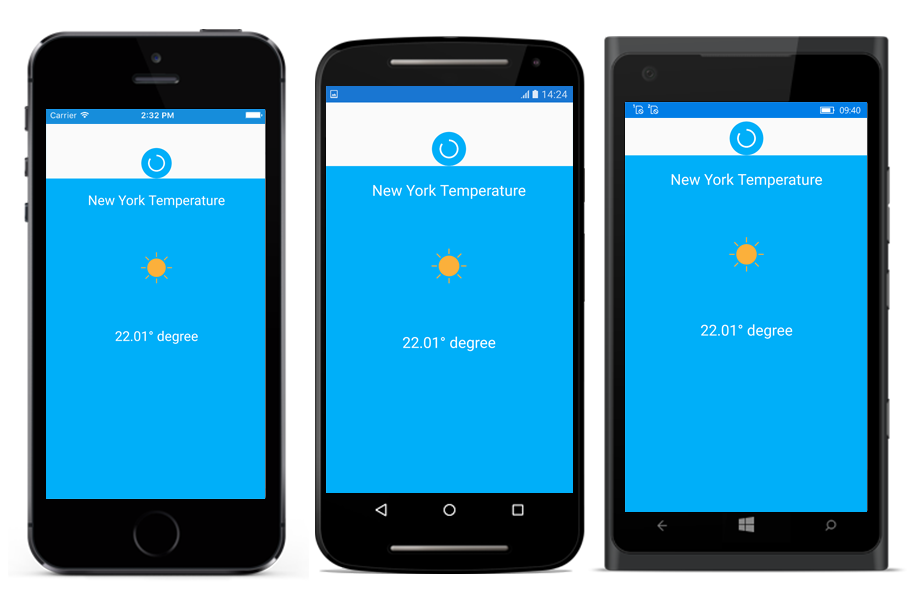
RefreshContentThreshold
Gets or sets the refresh content threshold value that indicates progress indicator starting position in view
<syncfusion:SfPullToRefresh x:Name="pullToRefresh" RefreshContentThreshold="50"/>pullToRefresh.RefreshContentThreshold = 50d;PullingThreshold
Gets or sets the value for the refresh content threshold, this indicate progress indicator maximum pulling position in view.
<syncfusion:SfPullToRefresh x:Name="pullToRefresh" PullingThreshold="200"/>pullToRefresh.PullingThreshold = 200d;IsRefreshing
Get or set the state for refreshing the view. View will get refresh while IsRefreshing property is set true and View refreshing will be stopped when you set IsRefreshing is false.
<syncfusion:SfPullToRefresh x:Name="pullToRefresh" IsRefreshing = "True"/>pullToRefresh.IsRefreshing = true;ProgressBackgroundColor
Get or set the background color to the progress indicator.
<syncfusion:SfPullToRefresh x:Name="pullToRefresh" ProgressBackgroundColor = "White"/>pullToRefresh.ProgressBackgroundColor = Color.White;ProgressStrokeColor
Get or set the color to the progress indicator stroke
<syncfusion:SfPullToRefresh x:Name="pullToRefresh" ProgressStrokeColor = "Blue"/>pullToRefresh.ProgressStrokeColor = Color.Blue;ProgressStrokeWidth
Get or set the width to the progress indicator stroke.
<syncfusion:SfPullToRefresh x:Name="pullToRefresh" ProgressStrokeWidth="5"/>pullToRefresh.ProgressStrokeWidth = 5d;RefreshContentWidth
Get or set the width to the refresh content.
<syncfusion:SfPullToRefresh x:Name="pullToRefresh" RefreshContentWidth="50"/>pullToRefresh.RefreshContentWidth = 50d;RefreshContentHeight
Get or set the width to the refresh content.
<syncfusion:SfPullToRefresh x:Name="pullToRefresh" RefreshContentHeight="50"/>pullToRefresh.RefreshContentHeight = 50d;Programmatic Support
StartRefreshing()
StartRefreshing method is used to refresh the content without interaction in pullable content. When invoke this StartRefreshing() method,then Progress indicator will be shown.
pullToRefresh.StartRefreshing();EndRefreshing()
EndRefreshing method is used to ends the progress animation of SfPullToRefresh.
pullToRefresh.EndRefreshing();Host SfDataGrid as pullable content
SfPullToRefresh controls provides support for loading any custom control as pullable content. To host SfDatagrid inside the SfPullToRefresh, follow the below steps.
- Add the required assembly references to the pcl and renderer projects as discussed in the Assembly deployment section of SfDataGrid and SfPullToRefresh .
- Import SfPullToRefresh and SfDataGrid control namespace as follows.
- Define SfDataGrid as PullableContent of the SfPullToRefresh.
- Handle the pull to refresh events for refreshing the data.
- Customize the required properties of SfDataGrid and SfPullToRefresh based on your requirement.
<xmlns:syncfusion="clr-namespace:Syncfusion.SfDataGrid.XForms;assembly=Syncfusion.SfDataGrid.XForms">
<xmlns:pull="clr-namespace:Syncfusion.SfPullToRefresh.XForms;assembly=Syncfusion.SfPullToRefresh.XForms">using Syncfusion.SfPullToRefresh.XForms;
using Syncfusion.SfDataGrid.XForms;This is how the final output will look like on iOS, Android and Windows Phone devices when hosting a SfDatagrid control as pullable content.
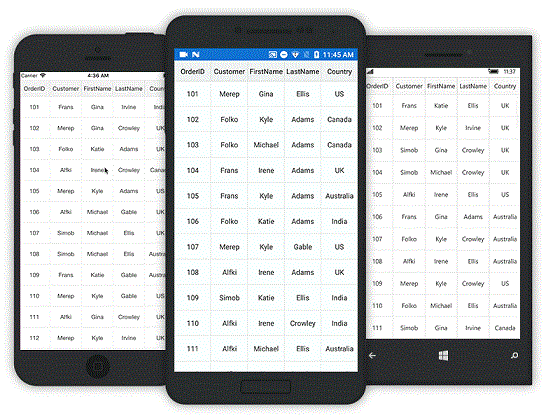
<?xml version="1.0" encoding="utf-8" ?>
<ContentPage xmlns="http://xamarin.com/schemas/2014/forms"
xmlns:x="http://schemas.microsoft.com/winfx/2009/xaml"
xmlns:local="clr-namespace:PullToRefreshSample"
x:Class="PullToRefreshSample.MainPage"
xmlns:syncfusion="clr-namespace:Syncfusion.SfDataGrid.XForms;assembly=Syncfusion.SfDataGrid.XForms"
xmlns:pull="clr-namespace:Syncfusion.SfPullToRefresh.XForms;assembly=Syncfusion.SfPullToRefresh.XForms">
<ContentPage.BindingContext>
<local:ViewModel x:Name="viewModel" />
</ContentPage.BindingContext>
<pull:SfPullToRefresh x:Name="pulltorefresh"
TransitionMode="SlideOnTop"
PullingThreshold="100"
RefreshContentHeight="30"
RefreshContentThreshold="40"
RefreshContentWidth="30">
<pull:SfPullToRefresh.PullableContent>
<syncfusion:SfDataGrid x:Name="dataGrid"
ItemsSource="{Binding OrdersInfo}"
AutoGenerateColumns="false">
<syncfusion:SfDataGrid.Columns>
<syncfusion:GridTextColumn MappingName="OrderID" />
<syncfusion:GridTextColumn MappingName="Customer"/>
<syncfusion:GridTextColumn MappingName="FirstName" />
<syncfusion:GridTextColumn MappingName="LastName" />
<syncfusion:GridTextColumn MappingName="Country" />
</syncfusion:SfDataGrid.Columns>
</syncfusion:SfDataGrid>
</pull:SfPullToRefresh.PullableContent>
</pull:SfPullToRefresh>
</ContentPage>using Syncfusion.SfPullToRefresh.XForms;
using Xamarin.Forms;
using Syncfusion.SfDataGrid.XForms;
namespace PullToRefreshSample
{
public partial class MainPage : ContentPage
{
public MainPage()
{
InitializeComponent();
pulltorefresh.Refreshing += PullToRefresh_Refreshing;
dataGrid.VerticalOverScrollMode=VerticalOverScrollMode.None;
}
private async void PullToRefresh_Refreshing(object sender, EventArgs args)
{
await Task.Delay(new TimeSpan(0, 0, 3));
viewModel.ItemsSourceRefresh();
pulltorefresh.IsRefreshing = false;
}
}
}
//Model class:
public class OrderInfo
{
public OrderInfo()
{
}
public string EmployeeID { get; internal set; }
public object FirstName { get; internal set; }
public object LastName { get; internal set; }
public string Country { get; internal set; }
public int OrderID { get; internal set; }
public string Customer { get; internal set; }
}
//ViewModel Class:
public class ViewModel
{
Random random = new Random();
public ViewModel()
{
}
#region ItemsSourceRefresh
public void ItemsSourceRefresh()
{
for (int i = 1; i <= 5; i++)
{
this.OrdersInfo.Insert(0, order.RefreshItemsource(i));
}
}
#endregion
}
//OrderInfoRepository Class:
public class OrderInfoRepository
{
public OrderInfoRepository()
{
}
private Random random = new Random();
#region GetOrderDetails
public ObservableCollection<OrderInfo> GetOrderDetails(int count)
{
ObservableCollection<OrderInfo> orderDetails = new ObservableCollection<OrderInfo>();
for (int i = 101; i <= count + 100; i++)
{
var order = new OrderInfo()
{
OrderID = i,
Customer = Customer[random.Next(5)],
EmployeeID = random.Next(1700, 1800).ToString(),
FirstName = FirstNames[random.Next(5)],
LastName = LastNames[random.Next(5)],
Country = country[random.Next(5)],
};
orderDetails.Add(order);
}
return orderDetails;
}
public OrderInfo RefreshItemsource(int i)
{
var order = new OrderInfo()
{
OrderID = (i + random.Next(100,110)),
Customer = Customer[random.Next(5)],
EmployeeID = random.Next(1700, 1800).ToString(),
FirstName = FirstNames[random.Next(5)],
LastName = LastNames[random.Next(5)],
Country = country[random.Next(5)]
};
return order;
}
#endregion
// Main DataSources
string[] FirstNames = new string[] {"Kyle","Gina","Irene","Katie","Michael"};
string[] LastNames = new string[] {"Adams","Crowley","Ellis","Gable","Irvine"};
string[] Customer = new string[] {"Alfie","Frans","Mered","Folios","Simon"};
string[] country = new string[] {"US","Australia","Canada","UK","India"};
}If we run the above sample with TransitionMode as Push, the output will look like on iOS, Android and Windows Phone devices as shown below.
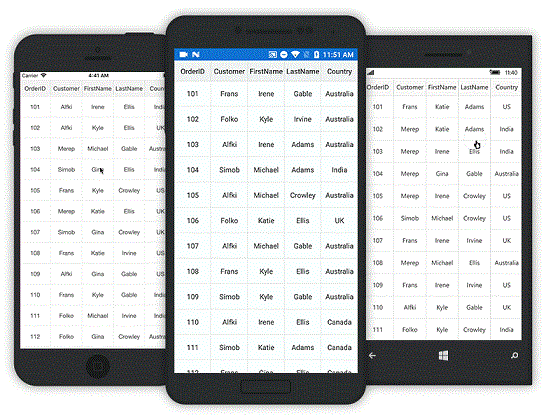
Host SfListView as pullable content
To host SfListView inside the SfPullToRefresh which is used to update items in the list while performing the pull to refresh action.
- Add the required assembly references to the pcl and renderer projects as discussed in the Assembly deployment section of SfListView and SfPullToRefresh .
- Import SfPullToRefresh control and SfListView control namespace as follows.
- Define SfListView as PullableContent of the SfPullToRefresh.
- Handle the pull to refresh events for refreshing the data.
- Customize the required properties of SfListView and SfPullToRefresh based on your requirement.
<xmlns:syncfusion="clr-namespace:Syncfusion.ListView.XForms;assembly=Syncfusion.SfListView.XForms">
<xmlns:pull="clr-namespace:Syncfusion.SfPullToRefresh.XForms;assembly=Syncfusion.SfPullToRefresh.XForms">using Syncfusion.SfPullToRefresh.XForms;
using Syncfusion.ListView.XForms;This is how the final output will look like on iOS, Android and Windows Phone devices when hosting a SfListView control as pullable content.
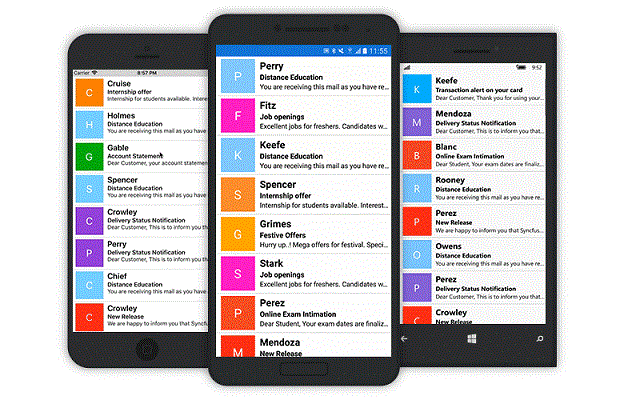
<?xml version="1.0" encoding="utf-8" ?>
<ContentPage xmlns="http://xamarin.com/schemas/2014/forms"
xmlns:x="http://schemas.microsoft.com/winfx/2009/xaml"
xmlns:local="clr-namespace:ListviewPulltorefresh"
x:Class="ListviewPulltorefresh.MainPage"
xmlns:syncfusion="clr-namespace:Syncfusion.ListView.XForms;assembly=Syncfusion.SfListView.XForms"
xmlns:pullToRefresh="clr-namespace:Syncfusion.SfPullToRefresh.XForms;assembly=Syncfusion.SfPullToRefresh.XForms" >
<ContentPage.BindingContext>
<local:InboxRepositiory x:Name="ViewModel" />
</ContentPage.BindingContext>
<ContentPage.Content>
<pullToRefresh:SfPullToRefresh x:Name="pullToRefresh"
PullingThreshold="60"
ProgressStrokeWidth="5"
ProgressBackgroundColor="CornflowerBlue"
ProgressStrokeColor="White"
RefreshContentWidth="40"
RefreshContentHeight="40"
TransitionMode="Push"
IsRefreshing="False">
<pullToRefresh:SfPullToRefresh.PullableContent>
<syncfusion:SfListView x:Name="listView"
ItemSize="80"
ItemsSource="{Binding InboxItems}"
ItemSpacing="0,0,0,1"
BackgroundColor="LightGray"
SelectionMode="None">
<syncfusion:SfListView.ItemTemplate>
<DataTemplate>
<Grid ColumnSpacing="5" BackgroundColor="White" Padding="5" >
<Grid.ColumnDefinitions>
<ColumnDefinition Width="80" />
<ColumnDefinition Width="*"/>
</Grid.ColumnDefinitions>
<StackLayout Grid.Column="0"
HeightRequest="70"
WidthRequest="70"
VerticalOptions="Center"
HorizontalOptions="Center"
BackgroundColor="{Binding BackgroundColor}">
<Grid HorizontalOptions="CenterAndExpand"
VerticalOptions="CenterAndExpand" >
<Label Text="{Binding DisplayString}"
TextColor="White"
FontSize="25"
HorizontalOptions="CenterAndExpand"
VerticalOptions="CenterAndExpand"/>
</Grid>
</StackLayout>
<Grid Grid.Column="1" RowSpacing="0">
<Grid.RowDefinitions>
<RowDefinition Height="Auto"/>
<RowDefinition Height="Auto" />
<RowDefinition Height="Auto" />
</Grid.RowDefinitions>
<Label Text="{Binding Sender}"
TextColor="Black"
FontAttributes="Bold"
FontSize="20"/>
<Label Grid.Row="1"
FontSize = "15"
TextColor="Black"
FontAttributes="Bold"
Text="{Binding Subject}"
LineBreakMode="TailTruncation" />
<Label Grid.Row="2"
FontSize="14"
TextColor="Black"
Text="{Binding Details}"
LineBreakMode="TailTruncation" />
</Grid>
</Grid>
</DataTemplate>
</syncfusion:SfListView.ItemTemplate>
</syncfusion:SfListView>
</pullToRefresh:SfPullToRefresh.PullableContent>
</pullToRefresh:SfPullToRefresh>
</ContentPage.Content>
</ContentPage>using Syncfusion.SfPullToRefresh.XForms;
using Xamarin.Forms;
using Syncfusion.ListView.XForms;
namespace PullToRefreshSample
{
public partial class MainPage : ContentPage
{
public MainPage()
{
InitializeComponent();
pullToRefresh.Refreshing += PullToRefresh_Refreshing; ;
}
private async void PullToRefresh_Refreshing(object sender, EventArgs e)
{
pullToRefresh.IsRefreshing = true;
await Task.Delay(2000);
ViewModel.RefreshItemSource();
pullToRefresh.IsRefreshing = false;
}
}
}If we run the above sample with TransitionMode as Push, the output will look like on iOS, Android and Windows Phone devices as shown below.

Pulling and refreshing template
The SfPullToRefresh allows you set a template for pulling and refreshing the view. The pulling and refreshing a template can be set using the SfPullToRefresh.PullingViewTemplate and SfPullToRefresh.RefreshingViewTemplate properties, respectively.
Refer to the following code example in which a SfProgressBar is loaded in the pulling view template and refreshing view template.
<?xml version="1.0" encoding="utf-8" ?>
<ContentPage xmlns="http://xamarin.com/schemas/2014/forms"
xmlns:x="http://schemas.microsoft.com/winfx/2009/xaml"
xmlns:local="clr-namespace:SfPullToRefresh"
x:Class="SfPullToRefresh.MainPage"
xmlns:dataGrid="clr-namespace:Syncfusion.SfDataGrid.XForms;assembly=Syncfusion.SfDataGrid.XForms"
xmlns:pullToRefresh="clr-namespace:Syncfusion.SfPullToRefresh.XForms;assembly=Syncfusion.SfPullToRefresh.XForms">
<ContentPage.BindingContext>
<local:OrderInfoRepository x:Name="viewModel"/>
</ContentPage.BindingContext>
<ContentPage.Content>
<pullToRefresh:SfPullToRefresh x:Name="pullToRefresh"
RefreshContentHeight="50"
RefreshContentThreshold="40"
PullingThreshold="150"
RefreshContentWidth="50"
ProgressStrokeWidth="8"
TransitionMode="SlideOnTop"
IsRefreshing="False">
<pullToRefresh:SfPullToRefresh.PullableContent>
<dataGrid:SfDataGrid x:Name="dataGrid"
AutoGenerateColumns="False"
ItemsSource="{Binding OrderInfoCollection}"
ColumnSizer="Star">
<dataGrid:SfDataGrid.Columns>
<dataGrid:GridTextColumn MappingName="OrderID" HeaderText="Order ID"/>
<dataGrid:GridTextColumn MappingName="CustomerID" HeaderText="Customer ID"/>
<dataGrid:GridTextColumn MappingName="Customer" HeaderText="Name"/>
<dataGrid:GridTextColumn MappingName="ShipCity" HeaderText="City"/>
<dataGrid:GridTextColumn MappingName="ShipCountry" HeaderText="Country"/>
</dataGrid:SfDataGrid.Columns>
</dataGrid:SfDataGrid>
</pullToRefresh:SfPullToRefresh.PullableContent>
</pullToRefresh:SfPullToRefresh>
</ContentPage.Content>
</ContentPage>public partial class MainPage : ContentPage
{
private SfCircularProgressBar progressbar;
private SfBorder border;
public MainPage()
{
InitializeComponent();
this.progressbar = new SfCircularProgressBar();
this.border = new SfBorder();
this.border.BorderColor = Color.LightGray;
this.border.BackgroundColor = Color.White;
this.border.CornerRadius = 35;
this.border.Content = this.progressbar;
this.border.BorderWidth = 0.2;
this.progressbar.SegmentCount = 10;
this.progressbar.IndicatorInnerRadius = 0.5;
this.progressbar.IndicatorOuterRadius = 0.7;
this.progressbar.ShowProgressValue = true;
this.progressbar.GapWidth = 0.5;
this.progressbar.WidthRequest = 70;
this.progressbar.HeightRequest = 55;
this.progressbar.IndeterminateAnimationDuration = 750;
var pullingTemplate = new DataTemplate(() =>
{
return new ViewCell { View = this.border };
});
this.pullToRefresh.Refreshing += this.PullToRefresh_Refreshing;
this.pullToRefresh.Pulling += this.PullToRefresh_Pulling;
this.pullToRefresh.PullingViewTemplate = pullingTemplate;
this.pullToRefresh.RefreshingViewTemplate = pullingTemplate;
}
private async void pullToRefresh_Refreshing(object sender, EventArgs e)
{
pullToRefresh.IsRefreshing = true;
await Task.Delay(new TimeSpan(0, 0, 3));
viewModel.ItemsSourceRefresh();
pullToRefresh.IsRefreshing = false;
}
private void PullToRefresh_Pulling(object sender, PullingEventArgs e)
{
this.progressbar.TrackInnerRadius = 0.8;
this.progressbar.TrackOuterRadius = 0.1;
this.progressbar.IsIndeterminate = false;
this.progressbar.ProgressColor = Color.FromRgb(0, 124, 238);
this.progressbar.TrackColor = Color.White;
var absoluteProgress = Math.Abs(e.Progress);
this.progressbar.Progress = absoluteProgress;
this.progressbar.SetProgress(absoluteProgress, 1, Easing.CubicInOut);
}
private async void PullToRefresh_Refreshing(object sender, EventArgs e)
{
this.pullToRefresh.IsRefreshing = true;
await this.AnimateRefresh();
this.progressbar.TrackInnerRadius = 0.1;
this.progressbar.TrackOuterRadius = 0.9;
this.viewModel.ItemsSourceRefresh();
this.pullToRefresh.IsRefreshing = false;
}
private async Task AnimateRefresh()
{
this.progressbar.Progress = 0;
this.progressbar.IsIndeterminate = true;
await Task.Delay(750);
this.progressbar.ProgressColor = Color.Red;
await Task.Delay(750);
this.progressbar.ProgressColor = Color.Green;
await Task.Delay(750);
this.progressbar.ProgressColor = Color.Orange;
await Task.Delay(750);
}
}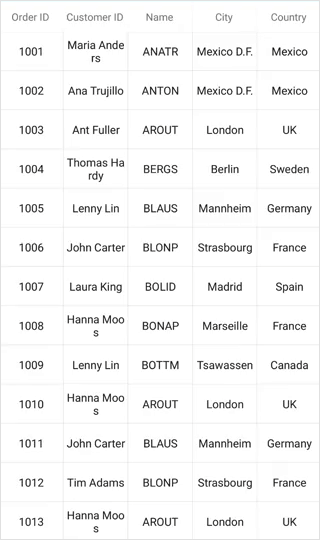
You can download the sample code by clicking the following link: Sample.